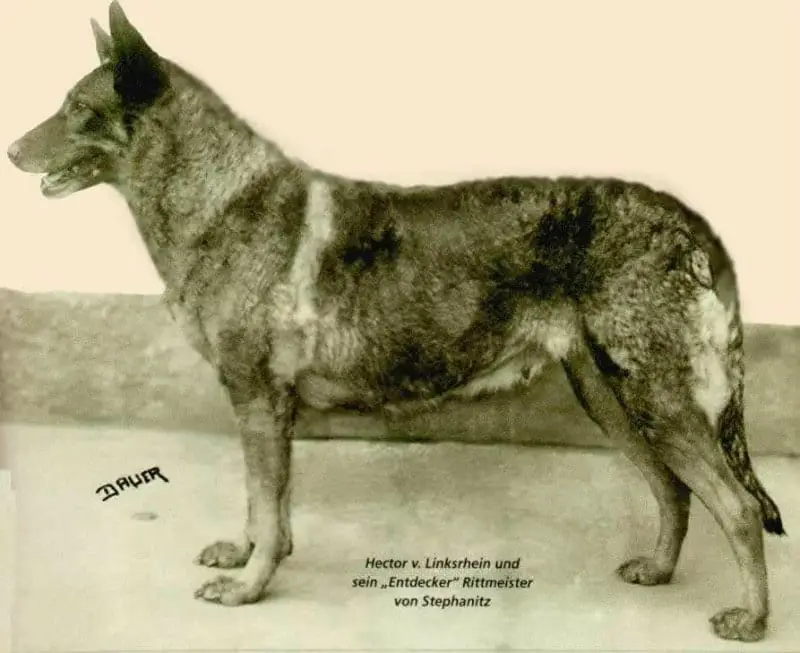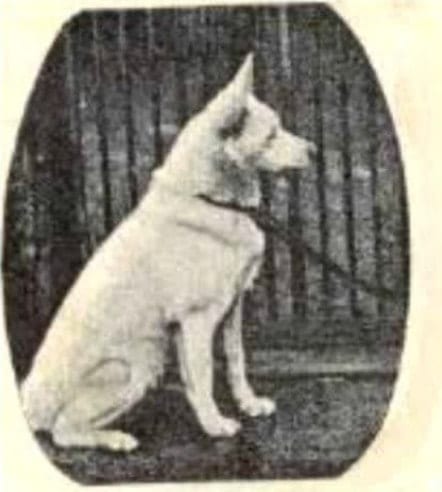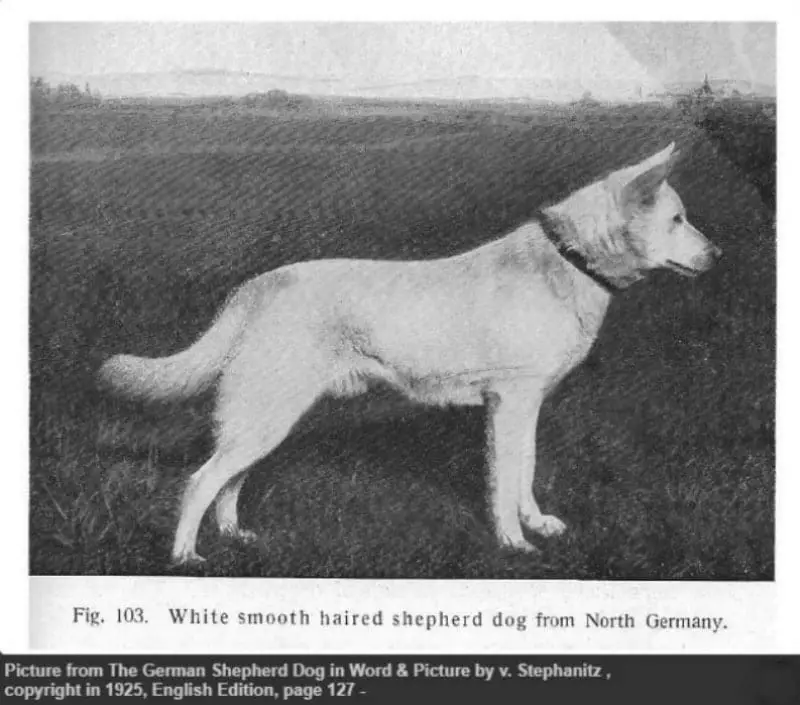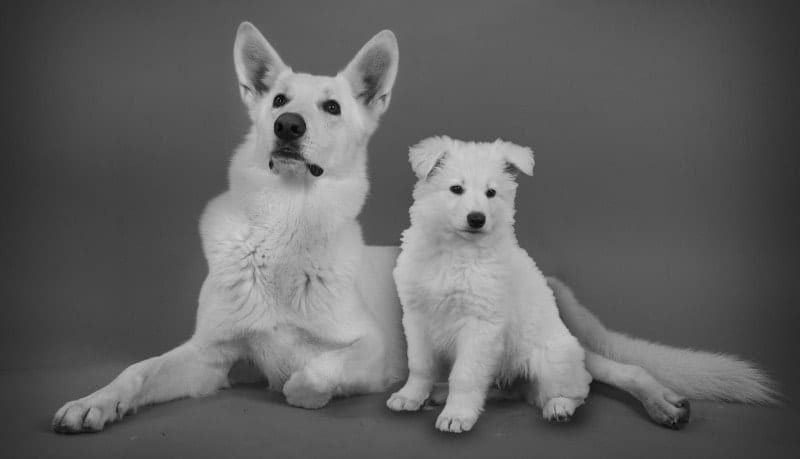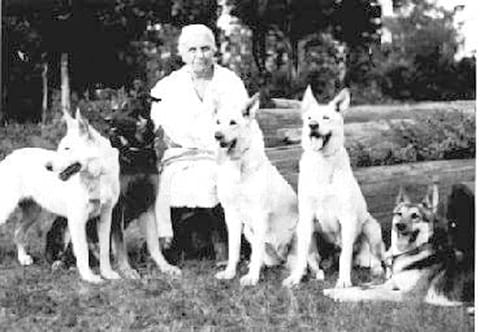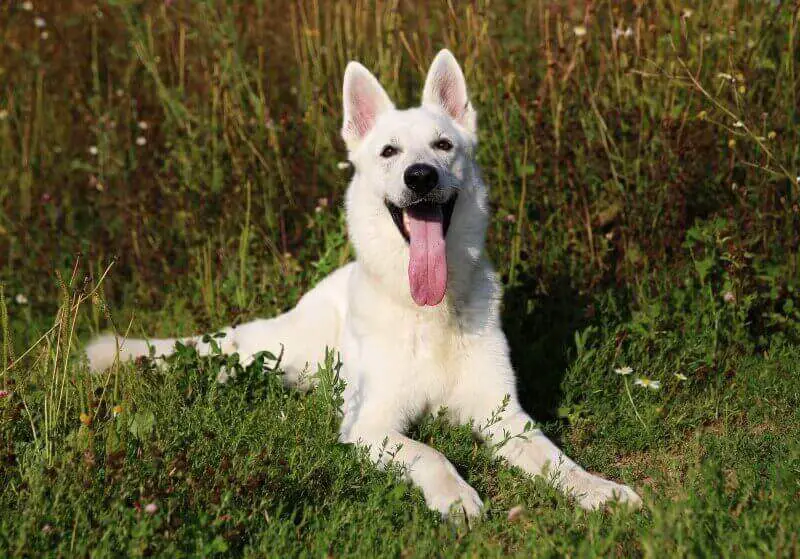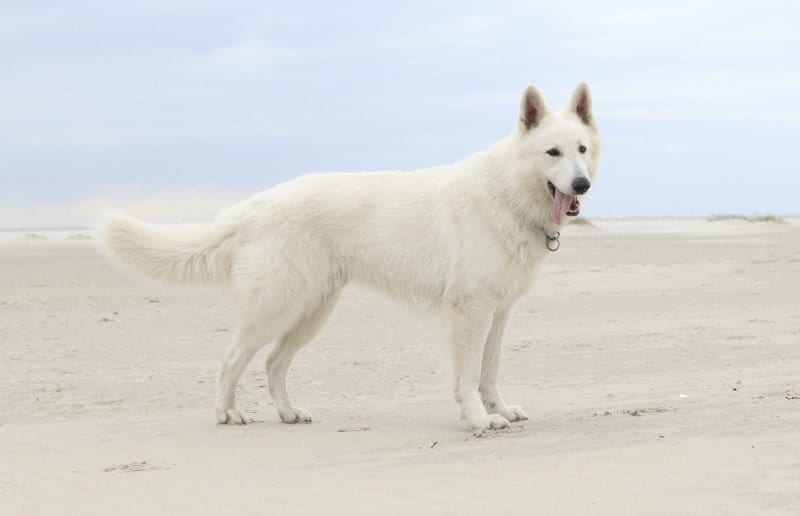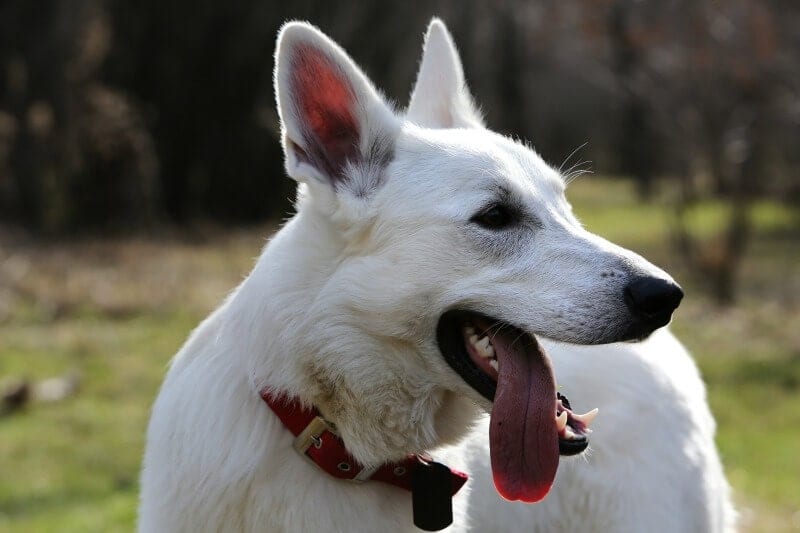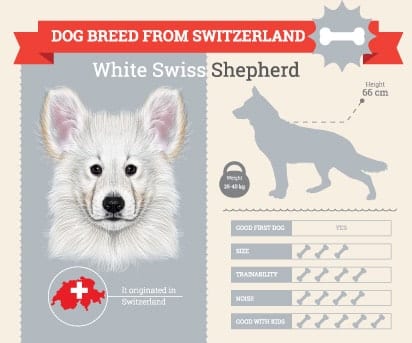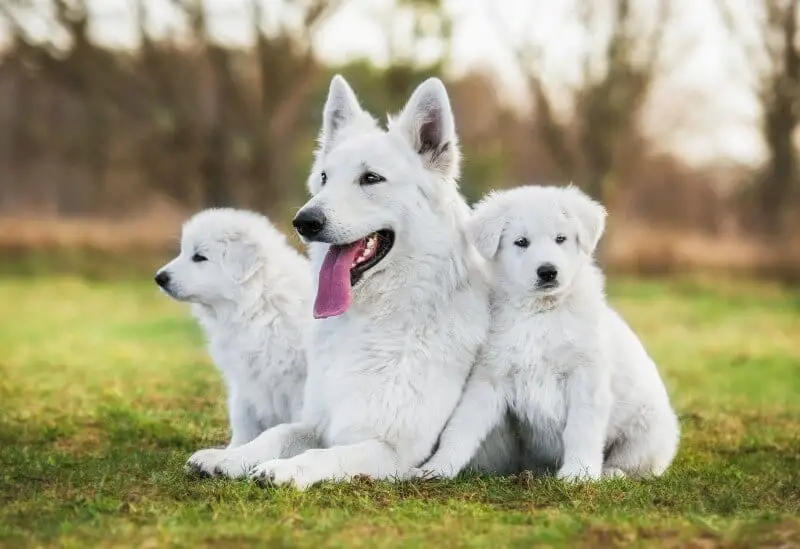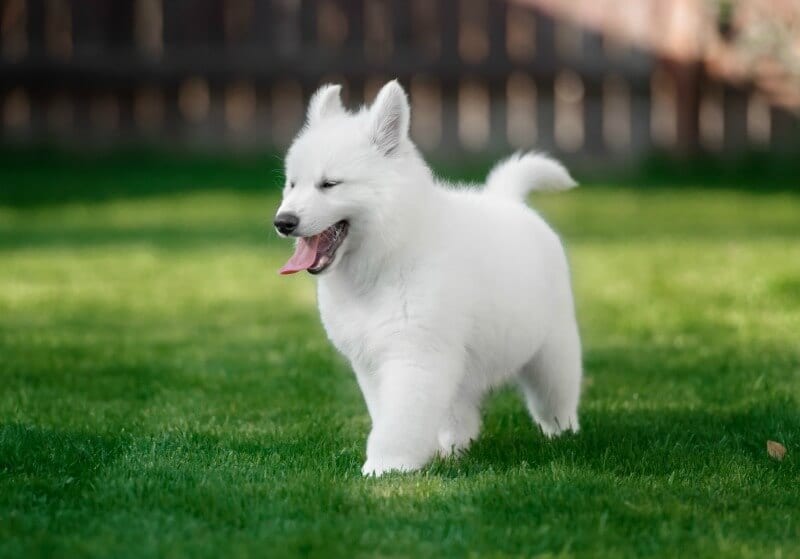What Is a White German Shepherd?
The White German Shepherd Dog is a German Shepherd with a pure white coat. White GSDs have the same traits, characteristics, and structure as their colored relatives.
The White German Shepherd Dog Club International, Inc. constitution states the FIRST objective of the Club shall be: “To preserve the name and heritage of the White German Shepherd Dog as an integral and inseparable part of the German Shepherd Dog breed.”
For years the White German Shepherd has been misunderstood and even ostracized as a defect in the German Shepherd breed.
The History of the White German Shepherd Dog
The German Shepherd Dog started as a valued European farm animal because it was an excellent herding dog and intensely loyal and obedient.
Many early herders preferred white-coated herding dogs such as the White German Shepherd, the Great Pyrenees, the Kuvasz, and the Police Tatra Mountain Dog. These white dogs blended into their flocks, making it easier to spot dark European wolves.
The German Shepherd breed began in 1889 at the hands of Captain Max von Stephanitz. Stephanitz purchased Hektor Linksrhein, who he renamed Horand von Grafrath.
Horand von Grafrath was the first registered German Shepherd Dog and the genetic basis for the modern German Shepherds we know and love today.
A historical dog who is not as well-known as Horand von Grafrath is a white-coat German herding dog named Greif von Sparwasser. Greif von Sparwasser was whelped in Herr Friedrich Sparwasser’s Frankfort kennel in 1879.
Friedrich Sparwasser breed both white and wolf (sable) colored herding dogs with upright ears and a body structure that resembles today’s modern German Shepherd Dog. Horand von Grafrath’s maternal grandfather is Greif von Sparwasser.
Captain Max von Stephanitz founded the Verein für Deutsche Schäferhunde (Society for the German Shepherd Dog) on April 22, 1899, and the fine-tuning of breeding the German Shepherd Dog began.
Linebreeding and inbreeding “color coat” dogs that carried Greif’s recessive gene for “white coats” were considered necessary to refine and create the desired traits in the breed.
As the 20th century progressed, more and more attempts were made to refine the science and expand the population of the still rare breed. German Shepherds steadily became larger and included black-and-tan, solid black, black-and-red, black-and-silver, sable, bi-color, liver, and white varieties.
In 1912 Anne Tracy of New York imported the first German Shepherds into the United States, and White German Shepherd puppies immediately showed up in the first litters.
In 1917 The American Kennel Club registered the first white German Shepherds from Anne Tracy’s New York kennel.
In 1921 Max von Stephanitz published “The German Shepherd Dog,” which included a photo of a celebrated white German Shepherd dog named Berno von der Seewiese, a direct descendant of Horand von Grafrath. In his book, Stephanitz stated, “The coloring of the dog has no significance whatsoever for service.”
The prime directive of Stephanitz’s breeding mandate was that the German Shepherd Dog breed must embody all the qualities of a working herding dog. He maintained that the beauty is in the working abilities of the dog; muscle, bone, joint, proud look and bearing, intelligence, stamina, and work ethic were the primary strengths sought in the breed.
Coat color never disqualified a dog from Stephanitz’s German Shepherd breeding standard.
Following World War I, the popularity of all White German Shepherd Dogs was equal to color-coated German Shepherds throughout the United States, Canada, and Mexico.
In 1933 discrimination against the White German Shepherd began. The German Nazi party took over all aspects of German society, including the breeding of the German Shepherd Dog.
Many of the elite in the Nazi party did not agree with Stephanitz that the breed should first embody the qualities of a working shepherd dog without regard to coat color.
Hitler disliked Stephanitz, who would not join the party and submit to his breed dictates. Nazi breed overseers continuously attempted to banish the breed founder and club president Stephanitz from the Dog Club he founded.
After thirty-six years of managing Germany’s German Shepherd Dog Club, Stephanitz gave up and left the Club in 1935. He died one year later, on April 22, 1936.
The Nazis, including Hitler, saw the white coat as an undesirable trait and further charged that the white-coated dog’s genes paled the darker coated dog’s colors. They thought the purity of the German Shepherd breed was polluted by the white-coated members.
The Nazi mentality blamed flaws such as deafness, blindness, albinism, mental instability, sterility, degeneration, and loss of vigor on the White German Shepherd. Once these beliefs took root, they flourished and grew, and some of these myths remain to this day.
By the end of World War II, Nazi Germany barred white German Shepherds from the conformation ring, declared White German Shepherds a disqualification in the German Shepherd breed standard, and began to cull white puppies from litters.
World War II did not affect the popularity of the White German Shepherd in America. White German Shepherds were fully accepted, registered, and shown at AKC dog shows through the late 1950s.
However, the discrimination against the White German Shepherd was not exclusive to the Nazis. Many dog breeders worldwide considered white or paler appearances in dogs a sign of inferiority and a genetic fault.
In the late fifties and early sixties, influential members of the German Shepherd Dog Club of America endorsed the German Club’s mandate for “breed purity.” They started a campaign to eliminate all dogs with the white trait from the gene pool.
There was a worldwide attempt to breed the recessive white gene out, but this gene was a lingering legacy of their forefather, Greif von Sparwasser.
In 1959 the German Shepherd Dog Club of America (GSDCA) adopted the exclusively colored breed standard of the parent German breed club, deeming the white coat as a disqualification.
Regardless of the White GSD being falsely blamed for genetic health problems in German Shepherd bloodlines, the White German Shepherd dog’s popularity increased during the 1960s. This caused friction between standard German Shepherd breeders and their White German Shepherd breeding counterparts.
In 1964 White German Shepherd lovers in Sacramento, California, formed the first White German Shepherd Dog Club to protect their beloved white dogs.
On April 6, 1968, the American Kennel Club (AKC) recognized the White German Shepherd as a pure breed and allowed them to be registered.
AKC registered White German Shepherd Dogs can compete in AKC performance events such as obedience, tracking, herding trials, and temperament testing but cannot compete in AKC conformation show rings in the United States.
The AKC considers the White German Shepherd a faulty color and is banned from confirmation events and titles.
In the latter half of the 20th century, it became clear that the breed had its fans, mainly in Canada and in the U.S., and throughout the entire world. The war to officially recognize White Shepherds began with their own breed clubs.
 In 1969, White German Shepherd supporters across the country joined the Sacramento club to form The White German Shepherd Dog Club of America.
In 1969, White German Shepherd supporters across the country joined the Sacramento club to form The White German Shepherd Dog Club of America.
The new club scheduled conformation shows for White German Shepherds vowed to protect the interests of white-coated German Shepherds and promote and display the quality of this breed to the world.
The White German Shepherd Dog Club of America adopted Stephanitz’s German Shepherd Dog breed standard and adjusted it to allow the white coat color and formally recognized the white dog as a member of Stephanitz’s German Shepherd Dog breed.
In 1977, the White German Shepherd Dog Club of America changed its name to The White German Shepherd Dog Club International, Inc. (WGSDCII) and continues in the United States to this day under that name.
In 1999 the United Kennel Club (UKC), the second-largest dog breed registry in the U.S., recognized the White German Shepherd as a separate breed.
Since 1969 White Shepherd clubs have independently formed in the United States and other countries to promote and protect the White German Shepherd.
While White German Shepherd Dog Clubs petition and fight for recognition, The German Shepherd Dog Club of America continues its campaign to eliminate white-coated shepherds from the breed and lobbying the AKC to stop registering white-coated shepherds.
A newer yet similar organization to The German Shepherd Dog Club of America is the United Schutzhund Clubs of America Inc. It also disqualifies and does not recognize the white version, German Shepherd.
White German Shepherd Myths
The following are myths about White German Shepherds which are false.
- White German Shepherds are a mixed breed
- White German Shepherds are albinos
- White German Shepherds can’t be registered with AKC
- White German Shepherds have more health issues than colored GSDs
- White German Shepherds live longer than colored GSDs
- White German Shepherds only come from White German Shepherd parents
The White German Shepherd Gene
There are many myths and misconceptions about the white color German Shepherd and the gene that carries their coat color.
German Shepherds have a white recessive gene that causes the white coat color and ONLY affects the coat color. The recessive trait acts as a mask that blocks the dog’s true color and markings and is responsible for the coat to be white.
The White German Shepherd is not an albino dog with deficient pigmentation. Albino creatures have NO pigment. Pure White GSDs have brown eyes, or dark eyes, pink skin or black skin, dark nails, a dark or black nose, and a dark color on their paw pads and around their mouth and eyes.
A White German Shepherd can produce standard colored puppies, and a standard colored German Shepherd can produce white puppies. Confused?
Breeding a White German Shepherd to a colored German Shepherd will produce colored puppies. BUT, if the colored German Shepherd carries the recessive white gene, there is a 50/50 chance that the puppies will be white or colored.
Unless genetically tested, there is no way to know if a colored German Shepherd carries the recessive white gene until bred. Even then, the recessive gene may lay dormant in the colored shepherd’s lineage until one day, surprise-a white puppy pops up.
The only way to 100% guarantee solid white German Shepherd puppies is by breeding two White German Shepherds together.
Breeding a White German Shepherd with a colored German Shepherd will not dilute or fade the coloring of the litter. This is a myth. The white gene does not make lighter-colored puppies.
The White German Shepherd does not have specific genetic disorders only caused by their coat color. This is another myth.
On the flip side, the White German Shepherd is not genetically prone to be healthier than a regular colored German Shepherd. The known health issues affecting the German Shepherd Dog breed have nothing to do with their coat color.
Genetic research has proven that White German Shepherds are not “faulty” and do not lessen or dilute the breed. Many hardcore German Shepherd elitists refuse to acknowledge the scientific research and insist on promoting the many misconceptions that started in the 1930s.
White German Shepherd Health Conditions
German Shepherds are susceptible to specific health issues. Health conditions in the German Shepherd have nothing to do with color and result from irresponsible breeding.
Large breed dogs often suffer from pannus as puppies and arthritis in their senior years. Other potential issues owners should be aware of are:
- Allergies
- Bloat
- Degenerative Myelopathy
- Elbow Dysplasia
- Hip Dysplasia
- Von Willebrand’s Disease
Owners need to understand that dogs, like people, aren’t perfect. Dogs of any breed can have health issues, especially into senior years.
Swiss White Shepherds Versus White German Shepherds
In 1967, a male White Shepherd was brought to Switzerland and bred with an imported white German Shepherd from the United Kingdom, giving birth to the Swiss Shepherd.
The White Swiss Shepherd is also known as the Weisser Schweizer Schäferhund, or Berger Blanc Suisse, and is from Switzerland.
The Berger Blanc Suisse is currently not recognized by the AKC but is recognized as a breed by the Federation Cynologique Internationale (FCI) in Europe.
The White Swiss Shepherd is considered a different breed but originates from the German Shepherd Dog, which creates a lot of overlap in the breed’s history and characteristics.
The White Swiss Shepherd’s size and structure are the same as a standard German Shepherd.
The White Swiss Shepherd and the White German Shepherd are almost identical in appearance. The most significant difference between the two breeds is in their stance.
White Swiss Shepherds stand more upright while White German Shepherds have more severe angulation in their stance.
The coat of the White Swiss Shepherd is slightly longer and heavier on the neck than a traditional German Shepherd.
The outer coat may vary between short hair or long hair, but the White Swiss Shepherd should always have a weather-resistant double coat, and the coat color is ideally as white as possible.
The disposition of the White Swiss Shepherd is generally mellower and has a more gentle personality than a standard German Shepherd.
Like a traditional shepherd, the White Swiss Shepherd is highly intelligent, loyal, athletic, and likes to work. They excel in sport work, search, and rescue, therapy work, or as service dogs.
The White Swiss Shepherd is not typically considered for police work or as a working dog, but it will protect its family without hesitation when necessary.
Is a White German Shepherd Right for You?
A White German Shepherd puppy starts out small and fluffy but quickly becomes a large dog. Adult males are bigger and weigh more than their female counterparts.
If you are thinking about getting a German Shepherd, your dog’s color boils down to personal preference.
Some people seek out White German Shepherds just as others prefer a Black German Shepherd, sable, black and red, black and tan, silver, etc.
There are many colors of the German Shepherd Dog. Regardless of the color you choose, it’s a good idea to research all aspects of this popular breed.
White German Shepherds are beautiful and majestic dogs. They are excellent family pets that are easily trained due to their high intelligence.
However, regardless of color, all German Shepherds are high energy and need socialization and consistent training from an early age, along with plenty of exercise and mental stimulation on a daily basis to thrive.
See if you and your home are ready for a German Shepherd by clicking here.
To find the perfect name for your new German Shepherd, click here.
How to Find Reputable White German Shepherd Breeders
Finding a reputable breeder is essential for any dog regardless of the breed.
White German Shepherds are not as common as colored German Shepherds because the all-white coat isn’t as popular as other color variations of the breed. However, a quick Google search will display people who specifically breed the white-colored German Shepherd.
Breeders who have White German Shepherd puppies that show up unexpectedly in a litter may want to quickly get rid of the white hair pups and sell them via word of mouth at a discounted price.
Breeders who specifically breed for White German Shepherd puppies may charge more for their pups. The price you pay for a puppy will depend on the breeder’s reputation, the breeding linage, and the health and temperament guarantees of the breeder’s pups.
The best way to find a new dog is to start with a Google search for White German Shepherds in your local area. Also, search rescue sites, clubs, or forums.
Do you know anyone who can recommend good breeders? Let friends, family, and acquaintances know you are looking and utilize social media.
If you find a breeder or a kennel, do more research. Do they have reviews or testimonials on their website or social media pages? Try to reach out and contact someone who has purchased one of their dogs.
To get you started, poke around The American White Shepherd Association. They have links to White German Shepherd breeders who are club members.
Summary
German Shepherds of any color are loyal, protective, intelligent dogs that make great family pets. However, they aren’t a good match for everyone.
German Shepherds are big dogs that take up more space and require daily exercise. If you are willing to devout time, training, positive reinforcement, and love into this breed, you will be rewarded with a protector and best friend for years to come.
If you want to stand out as a German Shepherd lover, a White German Shepherd might be the right dog for you.




